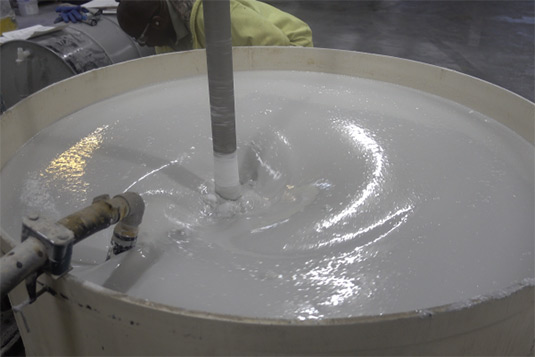Epoxy resin systems provide many technical advantages in flooring and are widely used in the construction industry today. A finished, hardened epoxy terrazzo floor does not pose any health risks. However, prior to the cure of epoxy terrazzo, components of epoxy resin may contain hazardous properties. This guide is helpful in educating people on epoxy resin safety when handling the material.

Like TERRAZZCO Brand Epoxy, many epoxy systems have two components, an epoxy resin, and a curing agent. Manufacturers of epoxy resin and floor installers must take precautions when handling these components as hazardous properties can lead to irritating or sensitizing effects. Epoxy systems are easy to work with and health risks are preventable if the necessary precautions are taken.

Epoxy Resin Safety: Prior to Handling Epoxy
Read the Product Labels
Many manufacturers of epoxy resins can inform users of the health risks by placing labels on their products. By placing hazard pictograms or warning labels on the product, people are aware of the potential risks of using the products and what to do in unfortunate circumstances. All users should follow product instructions carefully and review a manufacturer’s Safety Data Sheet prior to use.
What are the Potential Hazards?
A person can come into contact with epoxy resin while she or he is transporting materials, storing materials, mixing the components, spreading epoxy, cleaning tools, and disposing of containers. People are at greater risk of exposure when they are wearing improper gear, using unsuitable tools, or lacking awareness while handling the materials.
Common hazards include skin irritation, eye irritation, skin sensitization, and respiratory tract irritation. Avoid inhaling fumes and wear the appropriate gear to prevent contact.
Contact with epoxy may cause allergic reactions to some individuals. They may have swollen areas to parts of their body or may have asthma-like symptoms.
What Can Employers Do?
If employers know that their staff will often work with epoxy products, they can take certain measures to educate their employees, provide safety training, and establish emergency plans. Workplaces can develop standard operating procedures when manufacturing epoxy and make first aid kits and safety equipment readily available.
At the construction site, supervisors can provide adequate ventilation systems to keep chemical vapors from accumulating in the workspace. Fans and open windows can flow in the fresh air and reduce the levels of chemical vapors.
Workplaces should practice good maintenance. All employees should know how to clean up after the use of epoxy. They should know how to properly dispose of waste materials, clean tools, and store materials. Employees should also be trained on how to change out of contaminated clothes.
What Can Employees Do?
Employees should wear protective gear to prevent contact with the epoxy. After handling epoxy resin products, they should wash their hands thoroughly. All clothing and tools should be cleaned as well. Never should protective gear leave the building for safety purposes.
What Protective Gear is Recommended?
Eye Protection: Safety glasses, protective goggles, or face visors are recommended to prevent the epoxy from splashing into your eyes.
Gloves: The recommended gloves should be made from butyl rubber or nitrile, and can be pulled back to the forearm. Gloves made from latex, leather, or cotton are not sufficient to protect manufacturers and installers from epoxies. After each use, hands must be washed with clean running water, a mild soap, and dried off with clean towels.
Coveralls and Aprons: Coveralls and aprons add extra protection to work clothes and help protect the workers from chemicals that can soak into the soaks and come in contact with the skin.
In Case of Exposure
Eye Contact: Rinse cautiously with water for several minutes. Remove contact lenses, if present and easy to do. Continue rinsing. If eye irritation persists, seek medical attention.
Skin Contact: Wash with plenty of soap and water. Take off contaminated clothing. Wash contaminated clothing before reuse. If skin irritation or rash occurs, seek medical attention.
Inhalation: Take individuals to an area with fresh air and have them keep at rest in a position comfortable to breathing.
Ingestion: Drink plenty of water. Do not induce vomiting. Call a poison center or physician if you continue to not feel well.



